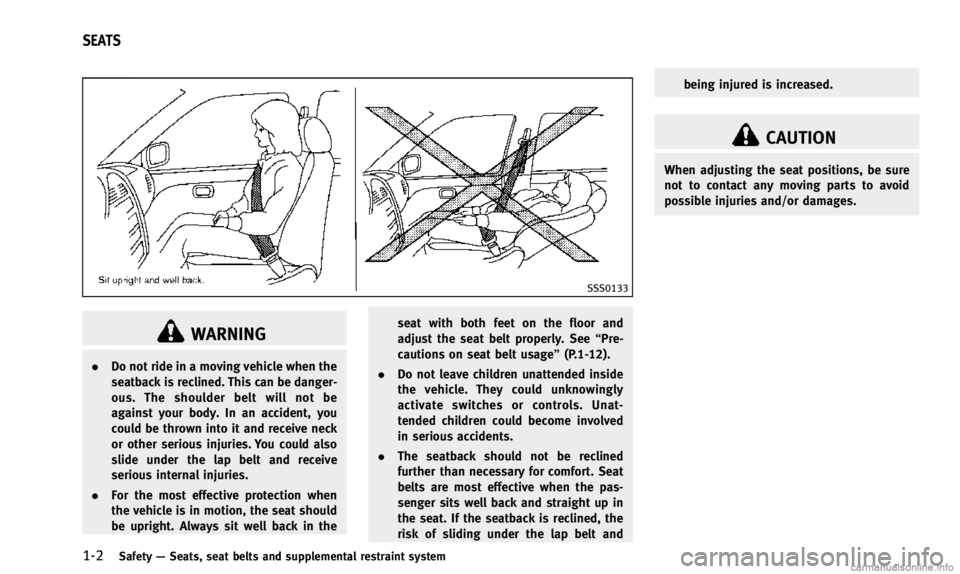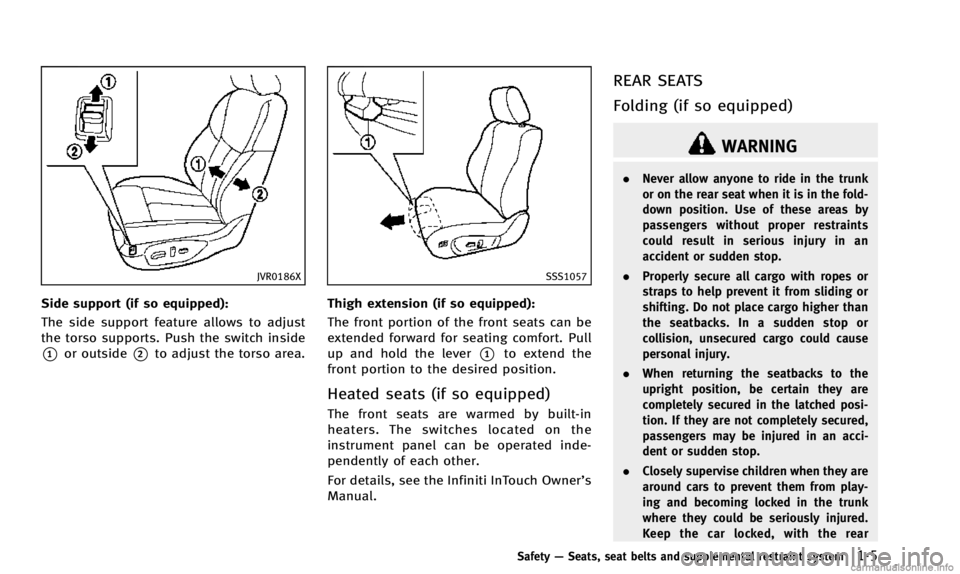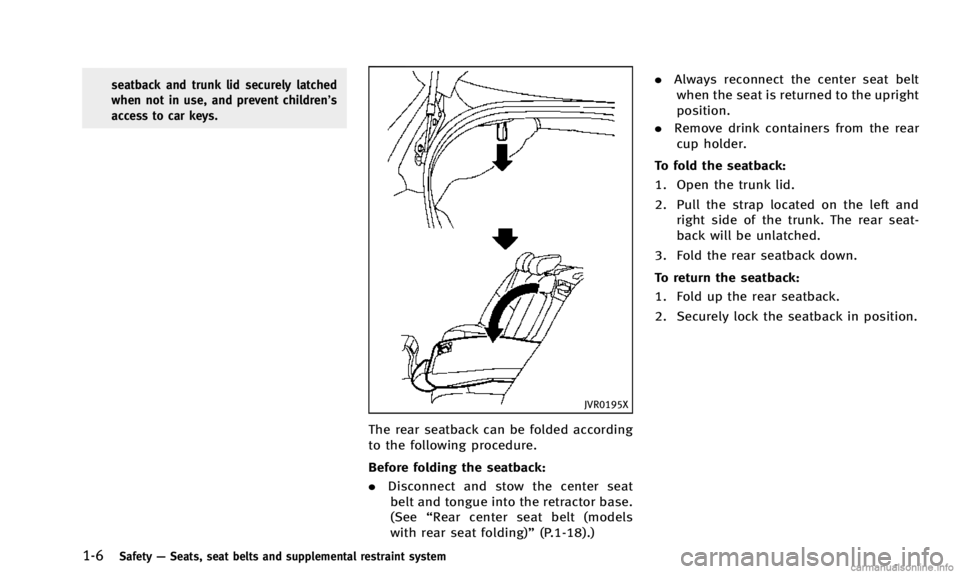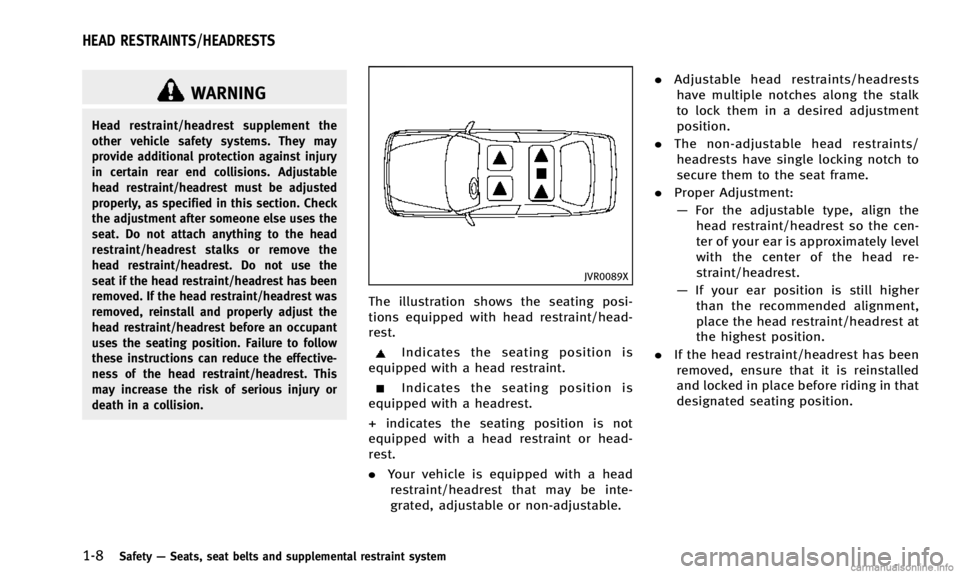INFINITI Q50 2014 Owner's Guide
Manufacturer: INFINITI, Model Year: 2014, Model line: Q50, Model: INFINITI Q50 2014Pages: 394, PDF Size: 1.99 MB
Page 21 of 394

1-2Safety—Seats, seat belts and supplemental restraint system
SSS0133
WARNING
. Do not ride in a moving vehicle when the
seatback is reclined. This can be danger-
ous. The shoulder belt will not be
against your body. In an accident, you
could be thrown into it and receive neck
or other serious injuries. You could also
slide under the lap belt and receive
serious internal injuries.
. For the most effective protection when
the vehicle is in motion, the seat should
be upright. Always sit well back in the seat with both feet on the floor and
adjust the seat belt properly. See
“Pre-
cautions on seat belt usage” (P.1-12).
. Do not leave children unattended inside
the vehicle. They could unknowingly
activate switches or controls. Unat-
tended children could become involved
in serious accidents.
. The seatback should not be reclined
further than necessary for comfort. Seat
belts are most effective when the pas-
senger sits well back and straight up in
the seat. If the seatback is reclined, the
risk of sliding under the lap belt and being injured is increased.
CAUTION
When adjusting the seat positions, be sure
not to contact any moving parts to avoid
possible injuries and/or damages.
SEATS
Page 22 of 394

FRONT SEATS
Front power seat adjustment
Operating tips:
.The power seat motor has an auto-reset
overload protection circuit. If the motor
stops during operation, wait 30 sec-
onds, then reactivate the switch.
. Do not operate the power seat switch
for a long period of time when the
engine is off. This will discharge the
battery.
See “Automatic drive positioner” (P.3-29)
for the seat position memory function (if so
equipped).
SSS1051
Forward and backward:
Moving the switch
*1forward or backward
will slide the seat forward or backward to
the desired position.
Reclining:
Move the recline switch
*2backward until
the desired angle is obtained. To bring the
seatback forward again, move the switch
*2forward.
The reclining feature allows adjustment of
the seatback for occupants of different
sizes for added comfort and to help obtain
proper seat belt fit. (See “Precautions on
seat belt usage” (P.1-12).) Also, the seat- back can be reclined to allow occupants to
rest when the vehicle is parked.
Safety
—Seats, seat belts and supplemental restraint system1-3
Page 23 of 394

1-4Safety—Seats, seat belts and supplemental restraint system
SSS1052
Seat lifter:
Push the front or rear end of the switch up
or down to adjust the angle of the front
portion or height of the seat.
SSS1053
Type A
Lumbar support (if so equipped):
The lumbar support feature provides lower
back support to the driver.
Type A
Push the front or back end of the switch to
adjust the seatback lumbar area.
SSS0836
Type B
Type B
Move the lever
*1up or down to adjust the
seatback lumbar area.
Page 24 of 394

JVR0186X
Side support (if so equipped):
The side support feature allows to adjust
the torso supports. Push the switch inside
*1or outside*2to adjust the torso area.
SSS1057
Thigh extension (if so equipped):
The front portion of the front seats can be
extended forward for seating comfort. Pull
up and hold the lever
*1to extend the
front portion to the desired position.
Heated seats (if so equipped)
The front seats are warmed by built-in
heaters. The switches located on the
instrument panel can be operated inde-
pendently of each other.
For details, see the Infiniti InTouch Owner ’s
Manual.
REAR SEATS
Folding (if so equipped)
WARNING
. Never allow anyone to ride in the trunk
or on the rear seat when it is in the fold-
down position. Use of these areas by
passengers without proper restraints
could result in serious injury in an
accident or sudden stop.
. Properly secure all cargo with ropes or
straps to help prevent it from sliding or
shifting. Do not place cargo higher than
the seatbacks. In a sudden stop or
collision, unsecured cargo could cause
personal injury.
. When returning the seatbacks to the
upright position, be certain they are
completely secured in the latched posi-
tion. If they are not completely secured,
passengers may be injured in an acci-
dent or sudden stop.
. Closely supervise children when they are
around cars to prevent them from play-
ing and becoming locked in the trunk
where they could be seriously injured.
Keep the car locked, with the rear
Safety —Seats, seat belts and supplemental restraint system1-5
Page 25 of 394

1-6Safety—Seats, seat belts and supplemental restraint system
seatback and trunk lid securely latched
when not in use, and prevent children’s
access to car keys.
JVR0195X
The rear seatback can be folded according
to the following procedure.
Before folding the seatback:
. Disconnect and stow the center seat
belt and tongue into the retractor base.
(See “Rear center seat belt (models
with rear seat folding)” (P.1-18).).
Always reconnect the center seat belt
when the seat is returned to the upright
position.
. Remove drink containers from the rear
cup holder.
To fold the seatback:
1. Open the trunk lid.
2. Pull the strap located on the left and right side of the trunk. The rear seat-
back will be unlatched.
3. Fold the rear seatback down.
To return the seatback:
1. Fold up the rear seatback.
2. Securely lock the seatback in position.
Page 26 of 394

SSS1061
ARMREST
Rear armrest
Pull the armrest forward until it is hor-
izontal.
JVR0187X
Trunk pass-through
The rear center seatback can be folded to
allow trunk access from inside of the
vehicle.
To access the trunk, pull down the rear
center armrest and pull out the trunk pass-
through lid
*1.
To lock the lid, use the mechanical key and
turn it to the LOCK position
*2. To unlock,
turn the mechanical key to the UNLOCK
position
*3. For the mechanical key usage,
see “Keys” (P.3-2).
Make sure that the mechanical key is
removed from the trunk pass-through lid key cylinder before opening or closing the
lid. Otherwise the lid and the rear armrest
may be damaged.
Safety
—Seats, seat belts and supplemental restraint system1-7
Page 27 of 394

1-8Safety—Seats, seat belts and supplemental restraint system
WARNING
Head restraint/headrest supplement the
other vehicle safety systems. They may
provide additional protection against injury
in certain rear end collisions. Adjustable
head restraint/headrest must be adjusted
properly, as specified in this section. Check
the adjustment after someone else uses the
seat. Do not attach anything to the head
restraint/headrest stalks or remove the
head restraint/headrest. Do not use the
seat if the head restraint/headrest has been
removed. If the head restraint/headrest was
removed, reinstall and properly adjust the
head restraint/headrest before an occupant
uses the seating position. Failure to follow
these instructions can reduce the effective-
ness of the head restraint/headrest. This
may increase the risk of serious injury or
death in a collision.
JVR0089X
The illustration shows the seating posi-
tions equipped with head restraint/head-
rest.
Indicates the seating position is
equipped with a head restraint.
Indicates the seating position is
equipped with a headrest.
+ indicates the seating position is not
equipped with a head restraint or head-
rest.
. Your vehicle is equipped with a head
restraint/headrest that may be inte-
grated, adjustable or non-adjustable. .
Adjustable head restraints/headrests
have multiple notches along the stalk
to lock them in a desired adjustment
position.
. The non-adjustable head restraints/
headrests have single locking notch to
secure them to the seat frame.
. Proper Adjustment:
— For the adjustable type, align the
head restraint/headrest so the cen-
ter of your ear is approximately level
with the center of the head re-
straint/headrest.
— If your ear position is still higher
than the recommended alignment,
place the head restraint/headrest at
the highest position.
. If the head restraint/headrest has been
removed, ensure that it is reinstalled
and locked in place before riding in that
designated seating position.
HEAD RESTRAINTS/HEADRESTS
Page 28 of 394

SSS0992
ADJUSTABLE HEAD RESTRAINT/
HEADREST COMPONENTS
1. Removable head restraint/headrest
2. Multiple notches
3. Lock knob
4. Stalks
JVR0203X
NON-ADJUSTABLE HEAD RE-
STRAINT/HEADREST COMPONENTS
1. Removable head restraint/headrest
2. Single notch
3. Lock knob
4. Stalks
SSS1037
REMOVE
Use the following procedure to remove the
head restraint/headrest.
1. Pull the head restraint/headrest up tothe highest position.
2. Push and hold the lock knob.
3. Remove the head restraint/headrest from the seat.
4. Store the head restraint/headrest prop- erly in a secure place so it is not loose
in the vehicle.
5. Reinstall and properly adjust the head restraint/headrest before an occupant
Safety —Seats, seat belts and supplemental restraint system1-9
Page 29 of 394

1-10Safety—Seats, seat belts and supplemental restraint system
uses the seating position.
SSS1038
INSTALL
1. Align the head restraint/headrest
stalks with the holes in the seat. Make
sure that the head restraint/headrest is
facing the correct direction. The stalk
with the adjustment notch
*1must be
installed in the hole with the lock knob
*2.
2. Push and hold the lock knob and push the head restraint/headrest down.
3. Properly adjust the head restraint/ headrest before an occupant uses the
seating position.
SSS0997
ADJUST
For adjustable head restraint/headrest
Adjust the head restraint/headrest so the
center is level with the center of your ears.
If your ear position is still higher than the
recommended alignment, place the head
restraint/headrest at the highest position.
Page 30 of 394

JVR0259X
For non-adjustable head restraint/head-
rest
Make sure the head restraint/headrest is
positioned so the lock knob is engaged in
the notch before riding in that designated
seating position.
SSS1035
Raise
To raise the head restraint/headrest, pull it
up.
Make sure the head restraint/headrest is
positioned so the lock knob is engaged in
the notch before riding in that designated
seating position.
SSS1036
Lower
To lower, push and hold the lock knob and
push the head restraint/headrest down.
Make sure the head restraint/headrest is
positioned so the lock knob is engaged in
the notch before riding in that designated
seating position.
Safety—Seats, seat belts and supplemental restraint system1-11